Inside The New York Botanical Garden
Programs and Events
Posted in Exhibitions, Programs and Events, The Edible Garden on August 12 2009, by Plant Talk
Learn How You Can Help
 |
Jenny Trotter is the Associate Director of Biodiversity Programs at Slow Food USA. When not at work this time of year, you’ll find her in her kitchen pickling something or experimenting with the week’s Community Supported Agriculture veggies. |
Have you ever heard of the Green Newtown Pippin apple? It was first picked on a farm around 1730 in a place we now call Queens. Thomas Jefferson grew it at Monticello and from Paris told James Madison, “They have no apple here to compare with our Newtown Pippin.” But despite its versatility and wonderful flavor, the Newtown Pippin—like hundreds of unique apple varieties—has lost the fight for shelf space to the picture-perfect but mealy and bland Red Delicious.
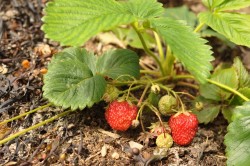 The Marshall Strawberry (pictured here) tells a similar tale. Did you know that this Massachusetts berry—dating back to 1890—was known as “the finest eating strawberry in the United States?” But as of five years ago, it was on the verge of extinction.
The Marshall Strawberry (pictured here) tells a similar tale. Did you know that this Massachusetts berry—dating back to 1890—was known as “the finest eating strawberry in the United States?” But as of five years ago, it was on the verge of extinction.
These are stories that will be told at the August 20 Edible Evening, “Preserving America’s Food Traditions.” I’ll be moderating a discussion, Restoring Heritage Varieties to Our Tables, about how home gardeners, orchardists, farmers, and chefs are all playing a role in conserving rare and place-based fruit and vegetable varieties…and how you can, too.
There are many reasons why we should care about preserving these foods, and it’s not because we’re nostalgic for the past or because of taste alone. Many people are starting to realize that our current fuel-intensive, globalized food system is not stable or secure enough to keep feeding us. In a Leopold Center for Sustainable Agriculture survey last year, only 15 percent of those surveyed felt assured that the global food system is safe anymore. Nearly three-quarters of the respondents felt that local and regional food systems would be more reliable in meeting the future nutritional needs of Americans. But to re-localize our food systems, we need each region to grow the grains, vegetables, fruits, and meats adapted to that climate rather than getting all our fruits from California and our beef from the Great Plains. Sadly, by sheer neglect of their value, we have put at risk nearly two-thirds of all the place-based heritage foods remaining on this continent that are adapted to regional climates, soils, and cultural traditions.
Read More
Posted in Exhibitions, Programs and Events, The Edible Garden on August 11 2009, by Plant Talk
 Unlike most Cubans, I adore hot peppers—in every size, shape, and form. When I first introduced them to my garden I started cautiously, first planting the hot cultivars that I knew would grow best in the warm, humid summers of New Jersey, where I live. But soon I began to scour the Internet for new sources of pepper seedlings, seeds, and whole pods, discovering that a single keyboard’s click could take me to a treasure trove of peppers, both hot and sweet, at online sites.
Unlike most Cubans, I adore hot peppers—in every size, shape, and form. When I first introduced them to my garden I started cautiously, first planting the hot cultivars that I knew would grow best in the warm, humid summers of New Jersey, where I live. But soon I began to scour the Internet for new sources of pepper seedlings, seeds, and whole pods, discovering that a single keyboard’s click could take me to a treasure trove of peppers, both hot and sweet, at online sites.
After three years I had graduated to about 100 cultivars from seeds and seedlings obtained in the U.S., with at least three seedlings of each specimen. (My collection represented the five domesticated species of the genus Capsicum: Capsicum annuum, C. baccatum, C. chinense, C. frutescens, and C. pubescens, all New World natives originating in South America.)
The peppers occupied not only every sunny patch of soil in my backyard but also an array of containers set on our brick patio, perched on garden tables and chairs, and overflowing onto the three garden tables I’d improvised from long planks of Ipe wood resting on metal sawhorses along our narrow driveway.
In return, by October I had vistas of beautiful, thriving plants with fruits of all colors and shapes, shining like miniature Christmas trees. What is best, my edible gardening project became the foundation of a pepper glossary for Saveur magazine appearing in the September 2009 issue (A World of Peppers: Chiles Bring a Lot More to the Table than Just Heat).
Read More
Posted in Programs and Events, The Edible Garden on August 7 2009, by Plant Talk
 |
Hilary Johnson, a freelance writer, is a volunteer for The New York Botanical Garden. |
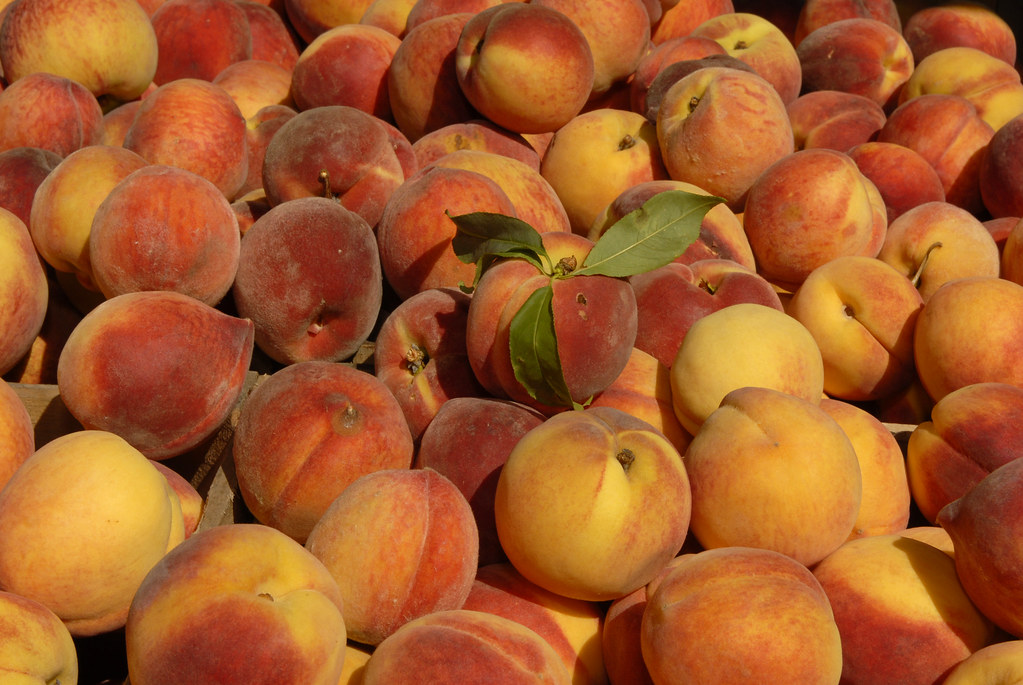 It’s Saturday. You’ve finally got a free day, and you want to cook up a storm. Maybe you’ll even invite some friends over for dinner. So, where are you going to shop? This year, the answer could be the Greenmarket at the Botanical Garden.
It’s Saturday. You’ve finally got a free day, and you want to cook up a storm. Maybe you’ll even invite some friends over for dinner. So, where are you going to shop? This year, the answer could be the Greenmarket at the Botanical Garden.
For the first time, the Garden’s Greenmarket is open also on Saturdays, not just Wednesdays. At the Mosholu Parking Lot, just across from the Mosholu Gate at Kazimiroff Boulevard, you can buy fresh, seasonal vegetables as well as breads, fruits, and desserts.
New Yorkers in all the boroughs already know about the City’s Greenmarkets. They’re some of the best places around to buy food. They give upstate farmers an opportunity to sell direct to consumers and City residents a chance to eat healthier, at reasonable prices.
Vanessa Sowell-Skeeter, 54, visited for the first time one recent Saturday (July 25). An elementary school teacher who lives nearby, Vanessa said she’s been meaning to come by the market for a while.
“Today I said, ‘Okay, this is my destination,’” she told me while shopping at the market. Looking over her purchases, she added, “I was able to find some things that I needed, and some things that look very tasty. So I’m happy.”
So was her daughter Njeri Johnson, 30, who’s a chef for private clients. Njeri, who also lives in the area, regularly visits Greenmarkets around the City, but Saturday was her first time at the Botanical Garden’s market. Among her purchases: cauliflower, string beans, and herbs from the two vegetable stands as well as some grass-fed black angus filet mignon and short ribs from Ledge Rock Farm in Medusa, New York.
Read More
Posted in Exhibitions, Programs and Events, The Edible Garden on August 5 2009, by Plant Talk
 |
Gayle Schmidt is Manager of Public Education. |
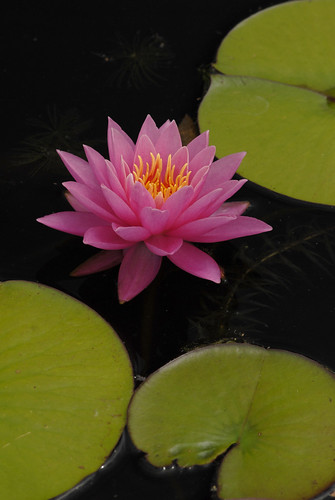 Imagine relaxing in a big backyard, enjoying a summer evening with friends along with good food, good music, and beautiful surroundings.
Imagine relaxing in a big backyard, enjoying a summer evening with friends along with good food, good music, and beautiful surroundings.
Well, you can do that right here at the Botanical Garden. On the next three Thursday nights beginning tomorrow, we continue our Edible Evenings series with a special addition—the Waterlily Concert series. These evenings are so fantastic, with great talent and friendly company to share in the event.
During Edible Evenings, the Garden’s hours are extended—until 8 p.m. for exhibitions and until 9 p.m. for the programs. In the cooler evening hours you can view the exhibitions in The Edible Garden, including Fruits, Roots, and Shoots, Martha Stewart’s Culinary Herb Garden, and the Beginners Vegetable Garden. Of course, you’ll also want to stop in to the Conservatory Courtyards to see Waterlilies and Lotus: An Aquatic Exhibition.
All evening at the Tasting Terrace you can sample beer and wine and specialty foods as well as learn about the research on edible plants by Garden scientists. You can also learn from Garden horticulturists about how to start your own herb or vegetable garden. Beer, wine, snacks, and sandwiches are available for purchase as you settle in for the cooking demonstrations and the concerts at the Conservatory Kitchen on the Conservatory Lawn. (The stage is adaptable to each event, so there is no need to re-orient your seating!)
The critically acclaimed Jeb Patton Trio will play a jazz set on August 6 following the infused tea demonstration by Mandy Aftel that complements the Coffee and Tea theme of the evening. She will show how to create scented teas and talk about the herbs and flowers such as jasmine, ginger, and rose used to make the teas.
Read More
Posted in Exhibitions, Programs and Events, The Edible Garden on August 4 2009, by Plant Talk
 |
Mandy Aftel creates artisan natural perfumes and is the co-author of Aroma, a cookbook that focuses on the essential link between food and fragrance. She will be presenting at this Thursday’s Edible Evening. |
Tea is a source of inspiration for me as a perfumer; it is a perfume we drink as it possesses aromas of wood, leather, and earth. In a great tea the taste as much as the smell will provide interest. Both tea and perfume are fragrant liquid: Tea is perfect harmony by nature, perfume by man.
Oolong teas, in particular, possess a diverse and appealing range of sophisticated, complex, and richly rewarding flavors and aromas such as peach, apricot, melon, leather, amber, and sandalwood. Oolong teas are made from large tea leaves, sometimes with the stem attached, because a more mature leaf yields more flavor during the partial oxidation in the manufacturing process.
My personal favorite oolongs are the green-leafed ones that are rolled into irregularly shaped balls. Fine oolongs require several successive infusions for the leaves to unfurl to their full extent. They do not open to their original size until the third or fourth infusion. Once fully open, oolongs can commonly be infused several more times—sometimes for as many as eight times. This is similar to a fine perfume that evolves on the skin over time, demanding new samplings of the aroma.
I have always loved everything about brewing, smelling, and drinking tea in beautiful ceramic teapots and cups. I wanted to bring my tea habit and my perfume work together, so I tried many dozens of oolong varieties, gravitating toward Dong Ding and Monkey-Picked Ti Quan Yen. Their aromatic complexity, the sophistication of their manufacture, and the long history of their development have no equal outside the French wine culture. With these two varieties I found the most interesting aroma and taste: They are complicated, rich, and able to stand up well to pairing with essential oils.
I decided to fragrance the Dong Ding using a beautiful jasmine with a hint of mint and the Monkey-Picked Ti Quan Yen with fresh ginger and Turkish rose. My creative process in making the tea was like the one I use in making a perfume— finding harmony among all the various aromas and flavors, like a marriage that brings out the best in both partners.
Posted in Programs and Events, Science on July 14 2009, by Plant Talk
 The edible squashes have been a staple food in the Western Hemisphere for more than 5,000 years. The Aztecs and Mayas, as well as the Native Americans who met the Pilgrims, depended upon the squashes as one of the “three sisters” (corn, beans, squash) of early agriculture in the Americas.
The edible squashes have been a staple food in the Western Hemisphere for more than 5,000 years. The Aztecs and Mayas, as well as the Native Americans who met the Pilgrims, depended upon the squashes as one of the “three sisters” (corn, beans, squash) of early agriculture in the Americas.
Though squashes come in an amazing variety—from tender summer zucchini to hearty acorn squash and pumpkins—their great diversity comprises only five species: Cucurbita argyrosperma, Cucurbita ficifolia, Cucurbita maxima, Cucurbita moschata, and Cucurbita pepo. (Bottle gourds, thought by Swedish botanist Carl Linnaeus to belong to Cucurbita, are now placed in a separate genus, Lagenaria. They are useful for a variety of utensils and handicrafts, although not as good for eating.)
The domesticated species of Cucurbita were all derived from different wild ancestors—wild species that have survived droughts, pests, and diseases without care from people. Although the wild ancestors bear small, hard, bitter fruits, they are very valuable for breeding disease resistance into modern food plants.
Thomas Andres, co-founder of The Cucurbit Network and an Honorary Research Associate at the Botanical Garden, has worked for 30 years with Garden scientist Michael Nee, Ph.D., on squash research. Andres will present a Gallery Talk in the Britton Science Rotunda and Gallery on Friday, July 17, at 2 p.m. about his beloved topic. Following his talk is a behind-the-scenes tour of the William and Lynda Steere Herbarium to see how scientists identify and classify plants and to view some specimens of squashes and their relatives.
Space is limited, please call 718-817-8703 for reservations.
Posted in Exhibitions, Programs and Events, The Edible Garden on July 3 2009, by Plant Talk
 |
Andrew Haight is Manager of the Everett Children’s Adventure Garden. |
Maps have always captured children’s imagination. Growing up I had every intention of becoming the next Indiana Jones. I hunted down buried “treasures” in my parent’s basement and made my own maps. I carefully crinkled the sheets, even tearing the corners to make the paper maps appear from “olden times.” The mystery and excitement seemed trapped on these sheets of paper; I felt they could lead me to new adventures.
This summer as part of The Edible Garden, maps will play a central role as we focus on the adventure in the Everett Children’s Adventure Garden through Flower Power!
Visitors can embark on their own journey through a series of activities laid out as a map inside each child’s field notebook. For instance, the map points out where a family can stop and make a pollinator puppet to take home and also guides children to several different activity and play stations, including a spot where they can mold their own flower out of clay.
The map allows children to choose their own route. Along the way they can discover the larger-than-life flower models, detour through Beth’s Maze, or simply take their time to explore each nook and cranny of the Garden. With the reins in each child’s hands in the form of a map, the possibilities are endless.
For more Edible Garden events and weekend activities, click here.
Posted in Programs and Events on June 18 2009, by Plant Talk
Excitement Builds Working with Star Chefs for The Edible Garden
 Jennifer Rothman is Associate Vice President of Children’s and Public Education.
Jennifer Rothman is Associate Vice President of Children’s and Public Education.
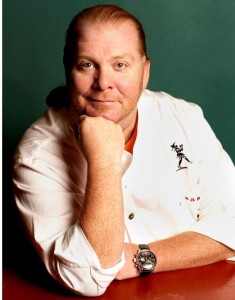 When the idea for The Edible Garden—our summer-long celebration of growing great food that begins June 27—began floating around, to say I was excited about the prospect of planning such an event is an understatement. You see, I am a bit of a foodie. When I’m not at work, I spend a lot of time thinking about food, cooking food, talking about food, reading about food…you get the picture. Now, after months of organizing this spectacular show, when I stand back and look at the lineup of celebrity chefs and gardeners who are featured, I keep thinking that if I didn’t work here, I would be the first person on line for tickets.
When the idea for The Edible Garden—our summer-long celebration of growing great food that begins June 27—began floating around, to say I was excited about the prospect of planning such an event is an understatement. You see, I am a bit of a foodie. When I’m not at work, I spend a lot of time thinking about food, cooking food, talking about food, reading about food…you get the picture. Now, after months of organizing this spectacular show, when I stand back and look at the lineup of celebrity chefs and gardeners who are featured, I keep thinking that if I didn’t work here, I would be the first person on line for tickets.
I mean, the chefs that are participating are “first-name famous”—Mario, Lidia, Martha—and at the top in their field. My Food Network favorites such as Daisy Martinez and Aida Mollenkamp are coming, too, as are the preeminent chefs of the local food movement like Dan Barber, who was just named James Beard Chef of the Year, and Peter Hoffman, a founding father of the movement.
Just last week I had the pleasure of being in the recording studio with Mario Batali while he recorded the narrations for our Edible Audio Tour. He was such a pro, finishing in less than an hour, and he couldn’t have been nicer. He told me that he and his family were big fans of The New York Botanical Garden and that they were excited to come visit this summer.
Read More
Posted in Programs and Events on June 17 2009, by Plant Talk
Shop Each Wednesday and Now Saturdays, Too
 Gayle Schmidt is Manager of Public Education.
Gayle Schmidt is Manager of Public Education.
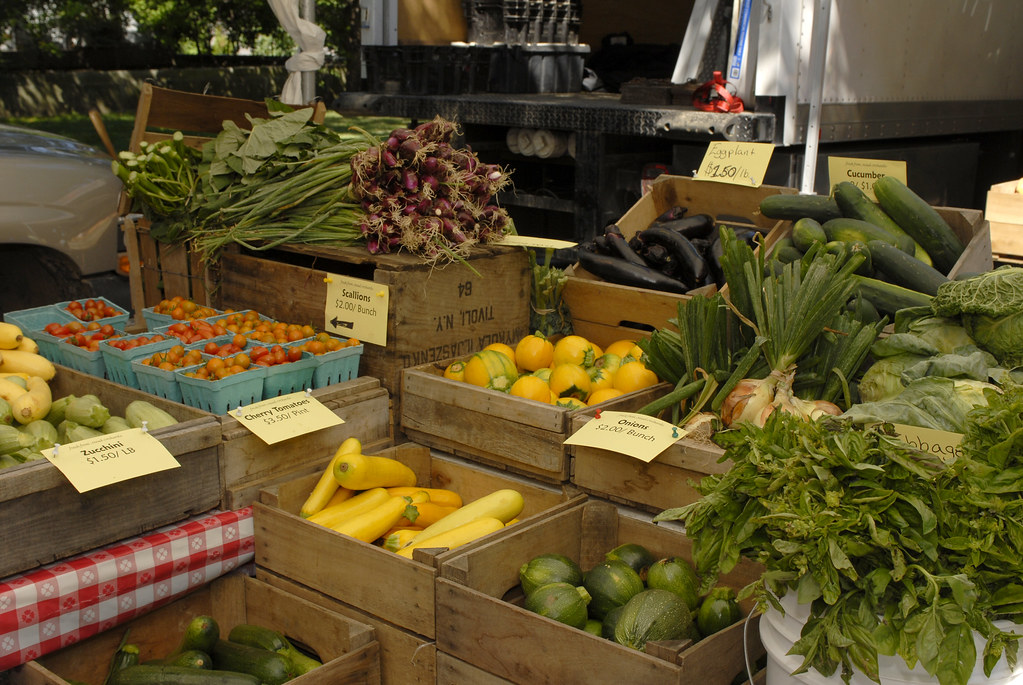 For weeks I haven’t been able to walk down the hallway without someone stopping me to ask, “When does the Farmers Market start?” Everyone at the Garden loves the season when we can purchase farm fresh goods at lunch hour and spend the rest of the afternoon planning recipes for dinner (well, in theory at least). Finally, I can let them know that the time is now—and that the Farmers Market is bigger and better than ever. We have expanded the Market to include Saturdays as well as Wednesdays, we have lengthened the daily hours, and we have increased the offerings to include meats and cheeses along with the colorful array of fruits, vegetables, honey, breads, and baked goods.
For weeks I haven’t been able to walk down the hallway without someone stopping me to ask, “When does the Farmers Market start?” Everyone at the Garden loves the season when we can purchase farm fresh goods at lunch hour and spend the rest of the afternoon planning recipes for dinner (well, in theory at least). Finally, I can let them know that the time is now—and that the Farmers Market is bigger and better than ever. We have expanded the Market to include Saturdays as well as Wednesdays, we have lengthened the daily hours, and we have increased the offerings to include meats and cheeses along with the colorful array of fruits, vegetables, honey, breads, and baked goods.
Farmers markets are a great way to learn more about where your food comes from and how delicious it can be when it has been picked within a day of your purchase. Greenmarket, part of the Council on the Environment of New York City and the largest open-air farmers market program in the country, has coordinated farmers and vendors since 1976 and maintains vigorous standards for sustainable farming and production. There are over 45 Greenmarket farmers markets throughout the City, and now the Botanical Garden’s can be counted among them.
Read More
Posted in Programs and Events on June 12 2009, by Plant Talk
 Gayle Schmidt is Manager of Public Education.
Gayle Schmidt is Manager of Public Education.
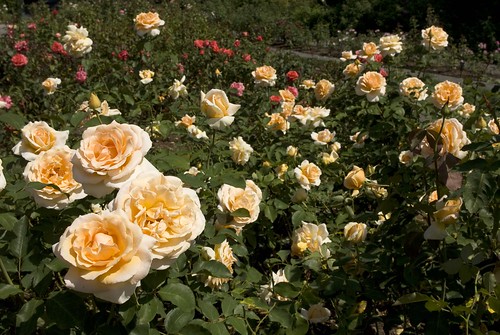 Wine and roses—what a romantic combination! Evening events at the Garden are among my favorite to organize. Even when I’m setting up and readying for the arrival of guests, the work is more relaxed and enjoyable. It is a different kind of busy than being in the office, because once the evening starts, I can enjoy it, too. The lengthening days allow us to be outdoors longer in June. The sun casts long streaks on the grass through the trees and a bright spotlight on the flowers and shrubs as it lowers in the sky. It is time to slow down and take in the day. It is so nice to make this peaceful time in the Garden available to our visitors as well.
Wine and roses—what a romantic combination! Evening events at the Garden are among my favorite to organize. Even when I’m setting up and readying for the arrival of guests, the work is more relaxed and enjoyable. It is a different kind of busy than being in the office, because once the evening starts, I can enjoy it, too. The lengthening days allow us to be outdoors longer in June. The sun casts long streaks on the grass through the trees and a bright spotlight on the flowers and shrubs as it lowers in the sky. It is time to slow down and take in the day. It is so nice to make this peaceful time in the Garden available to our visitors as well.
Following the success of our Kiku and Cocktails evening events this past fall, this month we are highlighting the first blooms of roses at the start of their long season with Wine and Roses evenings. You can kick off your weekend with a stroll among the hundreds of plants in the Peggy Rockefeller Rose Garden and succumb to the lure of these beautiful, scent-filled flowers as many have throughout the ages. Speak with the Curator, Peter Kukielski, and the rose gardeners themselves and learn about the different rose varieties, the new disease-resistant additions, and how the collection is cared for.
As you amble the paths, listen in the background for the live jazz, folk, or contemporary music dancing in the breeze and the gentle clinking of wine glasses celebrating the end of the week, the start of the summer, or the good company of friends. Why not spend an evening at the Garden? A great night for impressing a date, if I say so myself!
Check out all of Saturday’s programming
Check out all of Sunday’s programming

 The Marshall Strawberry (pictured here) tells a similar tale. Did you know that this Massachusetts berry—dating back to 1890—was known as “the finest eating strawberry in the United States?” But as of five years ago, it was on the verge of extinction.
The Marshall Strawberry (pictured here) tells a similar tale. Did you know that this Massachusetts berry—dating back to 1890—was known as “the finest eating strawberry in the United States?” But as of five years ago, it was on the verge of extinction.












